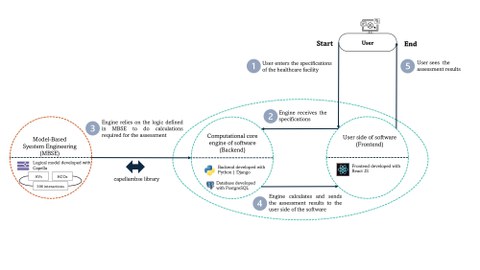A Software-Driven Assessment Solution Empowered by Model-Based Systems Engineering (MBSE) for Assessing the Architectural Variables of the Built Environment
Designing for people with dementia in healthcare facilities
As the global population of people with dementia is projected to reach 139 million by 2050, there is a growing focus on solutions supporting their Health and Care Outcomes (HCOs), one of which is dementia-friendly design in healthcare facilities. To design healthcare facilities that better align with the HCOs for people with dementia, it is necessary to thoroughly assess the effects of Architectural Variables (AVs) on HCOs. The more extensive the consideration of AVs' effects in design, the greater the capacity to achieve alignment between the built environment and HCOs. For this purpose, this PhD thesis develops a new software-driven assessment solution which assesses the effects of AVs on HCOs more effectively, shifting from traditional and manual tools towards systematic and digital solutions. Its development is guided by a methodology that addresses correspondingly three main challenges in previous assessment tools including lack of standard set of AVs and HCOs with widespread consensus, limitation in the holistic and systematic coverage of their interactions in the assessment calculations, and application difficulties of assessment tools.
Firstly, this thesis creates a new set of AVs and HCOs through terminology analysis and introduces a new structure of classification for allocating and positioning the AVs and HCOs. In the terminology analysis, AVs and HCOs were extracted from a source of studies, then through statistical and frequency analysis, representative terms with the most potential for consensus were identified. For the structure of classification, a new structure was developed for AVs and HCOs based on both theoretical and practical investigation approaches to meet a set of fundamental classification criteria.
Secondly, Model-Based Systems Engineering (MBSE), a subset of Systems Engineering, is utilized to model the interactions between AVs and HCOs. This approach enables the consideration of all different types of interactions between AVs and HCOs. It considers both direct interactions (AV-HCO) and indirect interactions, such as AV-HCO-HCO (an AV affects an HCO, which in turn affects another HCO) and AV-AV-HCO (an AV affects another AV, which then affects an HCO). Through systematic modeling with MBSE, a logical model has been developed that automates assessment calculations.
Thirdly, the application difficulties of the previous assessment tools are addressed through considerations in the software features and capabilities. Namely, the logical model obtained in the second step is integrated into the computational engine of the software to support it as a calculative engine without any need for manual intervention by users. Users can enter the specifications of the facilities supposed to be assessed through AVs of the software, then the assessment is carried out through data exchange between the computational engine and its logical model on the backend. The results of the assessment are displayed online through quantitative and qualitative analysis. Users are informed about how many negative or positive effects each HCO receives from which AVs. It also provides root cause analysis to clarify why an effect, whether positive or negative, occurs. The total result for all of the HCOs is also available.
Currently, the software conducts the assessment based on 396 interactions between AVs and HCOs, extracted from a source of previous studies. However, the MBSE is so developed that new findings could be added into the MBSE and subsequently automatically into the software, along with all relevant assessment calculations. This makes the software dynamic and adaptable to new findings. Moreover, the software was implemented in two real-world case assessments in Cambridge, UK. Additionally, expert feedback was gathered through interviews, including positive aspects as well as suggestions for further enhancements. Some of the suggestions include reflecting local cultural differences, integrating machine learning techniques, and automatically connecting to the database of studies.
Related publications
T. Golgolnia, G. Marquardt and M. Kevdžija. Are We Speaking the Same Language? Terminology Consistency in EBD. Health Environments Research & Design (HERD) Journal. 2023. Link to publication.
T. Golgolnia, M.Kevdžija and G. Marquardt. Proposing a Systematic Assessment Tool for Evaluating the Architectural Variables of Dementia-friendly Design in Nursing Home. Springer publications. 2023. Link to publication.
 © SGB
© SGB
PhD Student
NameTahere Golgolnia M.Sc.
Send encrypted email via the SecureMail portal (for TUD external users only).
Chair of Social and Health Care Buildings and Design
Visiting address:
BZW, 1. OG Raum B113 Zellescher Weg 17
01069 Dresden

